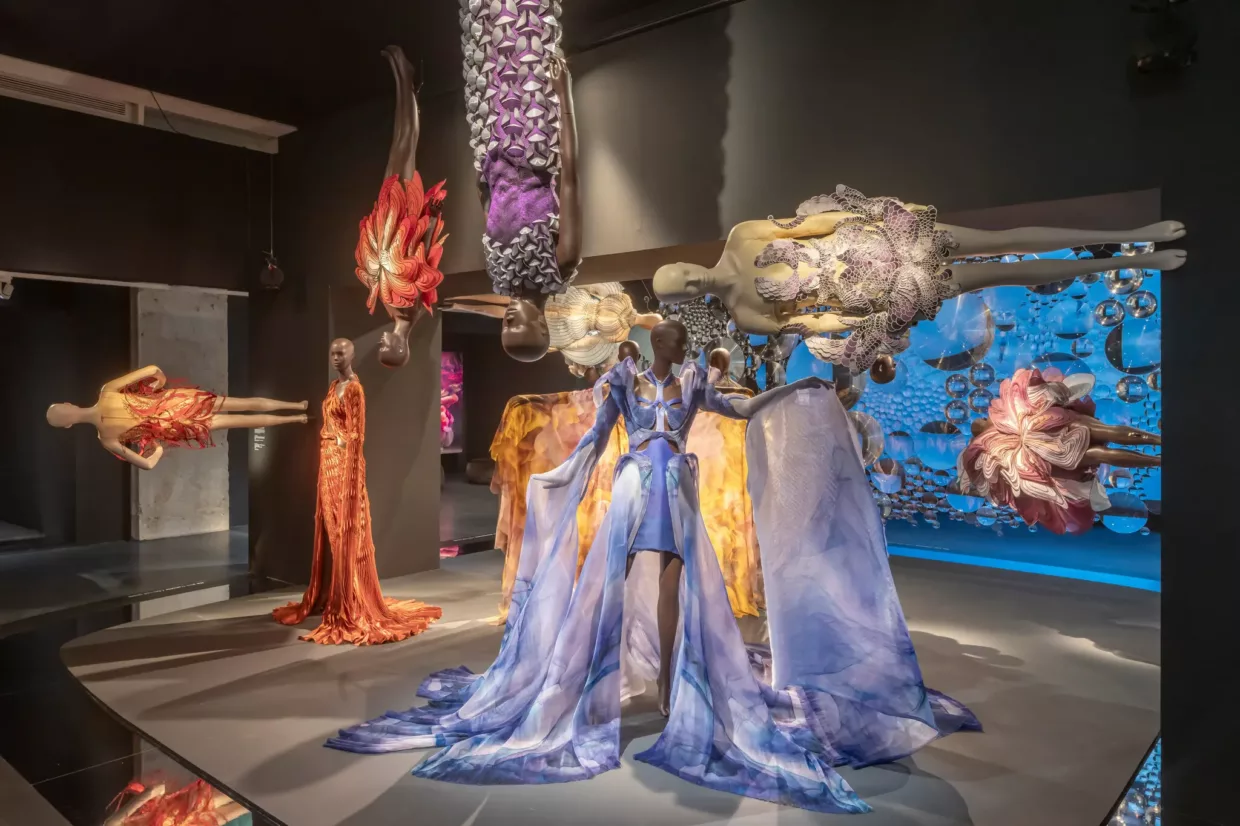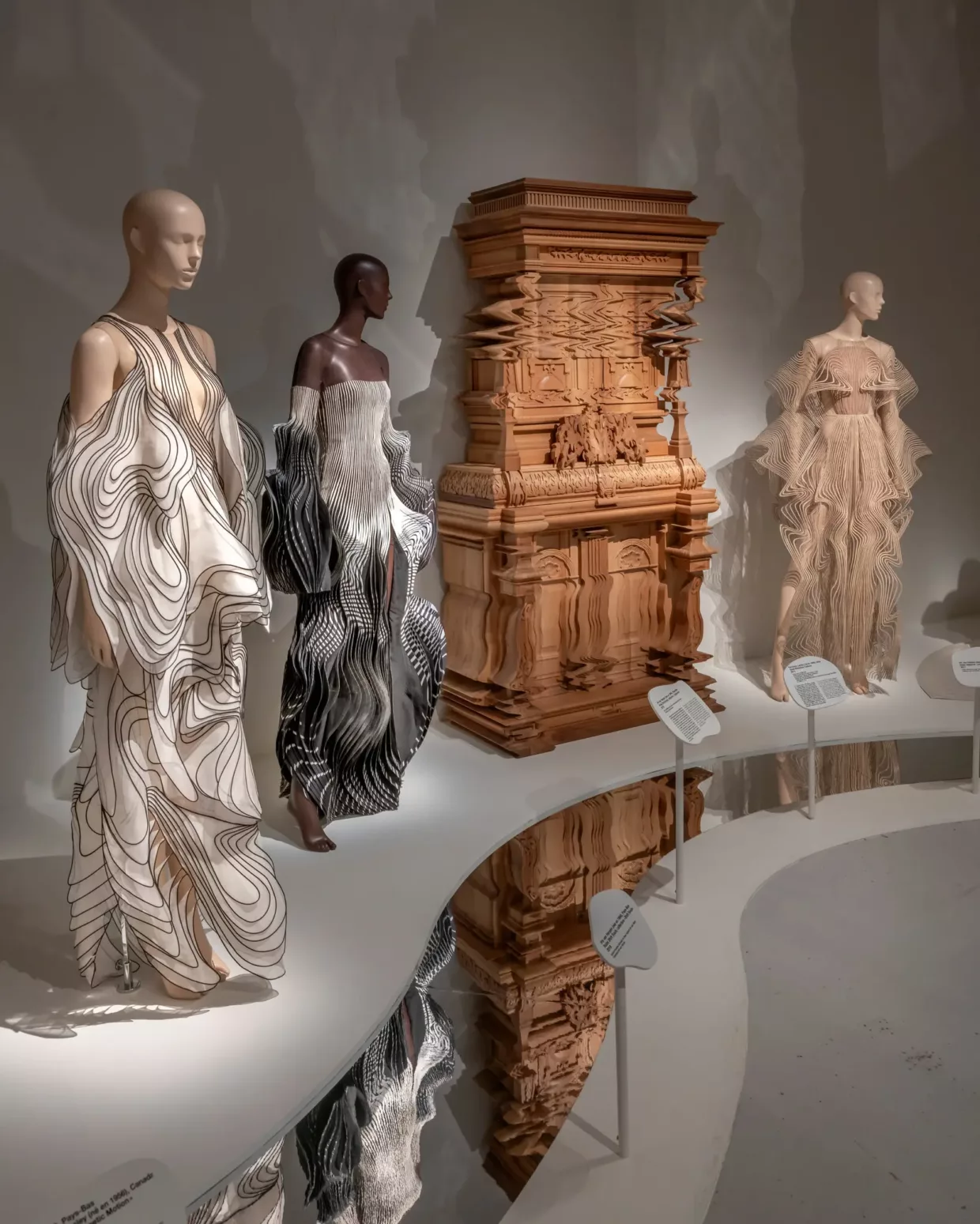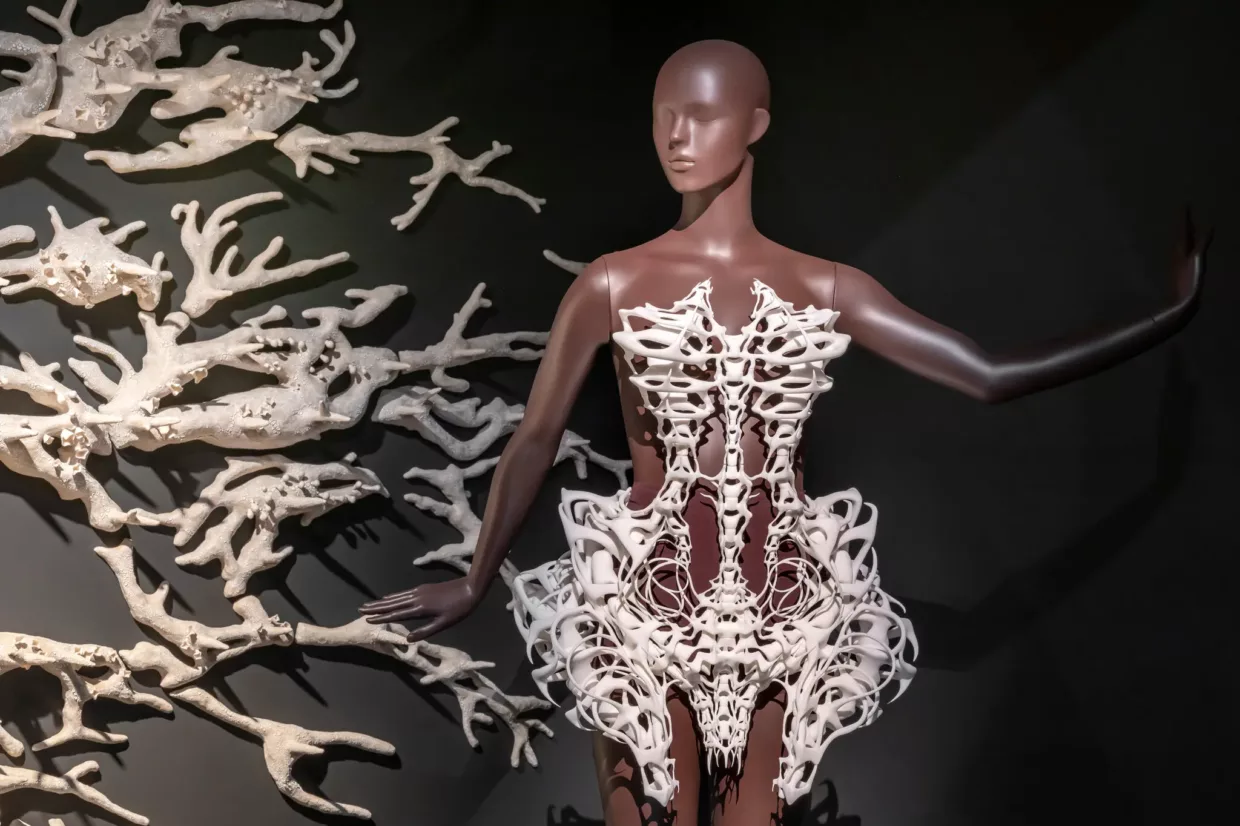The Cosmic Genius of Iris Van Herpen
Jan. 24, 2024
It is possible that the most dazzling couture show in Paris this week is not actually taking place on a runway at all, but in an entirely different sort of setting. Possible that said couture show is not an invitation-only affair with gold ballroom chairs and the latest celebrity du jour, but rather one open to the public. And certain that it is less about nostalgia for a past when couture was defined by the whispering of silk satin ball gowns, and more about a dream of the future.
The show in question? “Iris Van Herpen: Sculpting the Senses,” a one-woman exhibition that opened at the Musée des Arts Décoratifs in late November and scheduled to run through April 28.
Five years in the making, “Sculpting the Senses” crystallizes why Ms. Van Herpen, 39, is the youngest female designer to be granted a solo show at the museum in its 140 years of existence. And why, more than a decade after being invited to join the ranks of Paris’s couturiers, Ms. Van Herpen has also been made a Chevalier des Arts et Lettres, an honor presented by the French Ministry of Culture.
“She has managed to create a unique world, somewhere between fairy tale and science fiction,” said Christine Macel, director of the Musée des Arts Décoratifs. “In my opinion, she is unique and essential.”
Though couture is generally referred to as fashion’s “laboratory,” its place of “experimentation” — in part because, as a made-to-order art, it can be as wildly inaccessible and expensive as it needs to be — it also is often treated as an anachronism. Seen as a relic of another time, before technology; part of a cultural legacy, sure, but without much use beyond the red carpet and fabulous Instagram content.
Ms. Van Herpen’s work, which takes the whole idea of the “lab” at face value (she is a regular visitor to CERN’s Large Hadron Collider in Switzerland, and there three microscopes are included in the exhibition), is an authoritative rebuttal of this idea, made in cloth.
Or rather in 3-D printing, tulle, Mylar, lace, silicon and organza.
Conceived as a journey through which the interrogation of creativity effectively mimics the explosion of life, the exhibition is not a retrospective, but rather an inquiry in nine stages. One that begins with water and proceeds through earth, body and ecosystems before culminating in what the exhibition calls a “cosmic bloom.”
Scattered among the 100 or so dresses and accessories on display — the sorts of otherworldly clothes that flirt with the familiar even as they defy explanation (Is that a dress made of … air bubbles? A splash frozen in air? The skin of a praying mantis? A gown for a Martian coronation?) — are approximately 80 items lent by artists, architects and institutions around the world.
It’s not that the works are the inspiration for the clothes. That would be an awfully trite interpretation. But rather they exist in a dialogue with the garments, taking the viewer inside Ms. Van Herpen’s omnivorous brain and situating fashion in the continuum of abstract approaches to understanding and interpreting the world.
“Sometimes people perceive fashion as a bubble, which it is, in a way,” Ms. Van Herpen said, discussing how she and the curator Cloé Pitiot structured the show. “But I think fashion has such a big connection with other layers of life; with psychology, philosophy, science, society. The more you open yourself to it, the more you can discover within it.”
To wit: a dress of iridescent watery abstraction that contains its own in ebb and flow, displayed next to delicate pen and ink illustrations of an octopus by the 19th-century French naturalist Charles-Alexandre Lesueur. And both are next to a 2023 underwater video that Ms. Van Herpen made in place of a runway show with the free-diver, dancer and filmmaker Julie Gautier, in which aquatic dresses swirl not just up and down but all around.
A curvy little mini dress that looks like it was pieced together from the wood of an ancient cathedral complete with arches and flying buttresses (but which is actually made of copper-electroplated 3-D printed polyamide) stands near a video projection from the 2015 biosystems documentary “Terra” by Yann Arthus-Bertrand and Michael Pitiot.
And a delicate bleached-white ray skeleton abuts a 2011 Van Herpen “skeleton” dress made in collaboration with Isaïe Bloch, a Belgian architect; a suit of samurai armor mixes it up with a frock composed of metallic neck pieces circumnavigating the body; and stills taken by the James Webb Space Telescope are the backdrop to a dress made from hundreds of golden organza petals, looking like a lionfish in air. To give a few examples.
The effect is to bring the viewer inside Ms. Van Herpen’s own neural network, an awfully privileged place to be.
Along with two additional rooms that ground the high-concept approach in the business of life — a “cabinet of curiosities” which features vitrines of beetles, an antique copy of Ovid’s “Metamorphoses” and Ms. Van Herpen’s 3-D printed insectoid footwear; the “atelier,” where fabric swatches are displayed like pointillist art on each wall along with doll-like mannequins that embody the design process — it’s like a glimpse into the process of creation.
To deepen the experience, each “stage” of the show includes its own sound installation composed by Salvador Breed, Ms. Van Herpen’s partner. The only frustration is not being able to touch the garments, which can look wearer-unfriendly but are often much softer and more pliable than they appear. As is evidenced by a wall that connects one floor of the 1,280-square-meter (13,780-square-foot) show to the next, displaying a photographic collage of celebrities such as Lady Gaga, Jennifer Lopez and Beyoncé wearing Ms. Van Herpen’s work while out in the world. (The designer insists many of her pieces can go in the washing machine, though that is hard to imagine.)
Still, in the show’s next incarnation Ms. Van Herpen is hoping to incorporate touch. The exhibition has been so popular (with lines outside behind the velvet rope every day and the museum now staying open later on Saturdays and Sundays to satisfy demand) that there are plans for it to travel to Brisbane, Australia; Singapore; Rotterdam, the Netherlands (Ms. Van Herpen is Dutch and based in Amsterdam); and potentially the United States.
In the final room, a curtain of acrylic lenses by the Japanese artist Haruka Kojin provides a solar system setting for a cluster of mannequins situated not just on the floor but hanging down from the ceiling, like stalactites, and jutting horizontally from the walls of the room, effectively altering the viewer’s understanding of the very physics of material, since no matter the orientation, the clothes themselves remain suspended in space. Despite what you might presume, there are no secret wires or secret structures involved. Ms. Van Herpen has simply figured out how to give the dresses their own gravity.
It’s a reminder that her genius has always been in understanding that technology and couture are not oppositional forces — that, in many ways, the sewing needle was simply an early mechanical tool — and that the one can be harnessed to realize the potential of the other. Given the current fears and conversations around A.I., it is a palpably optimistic note on which to end.
Source: The New York Times






